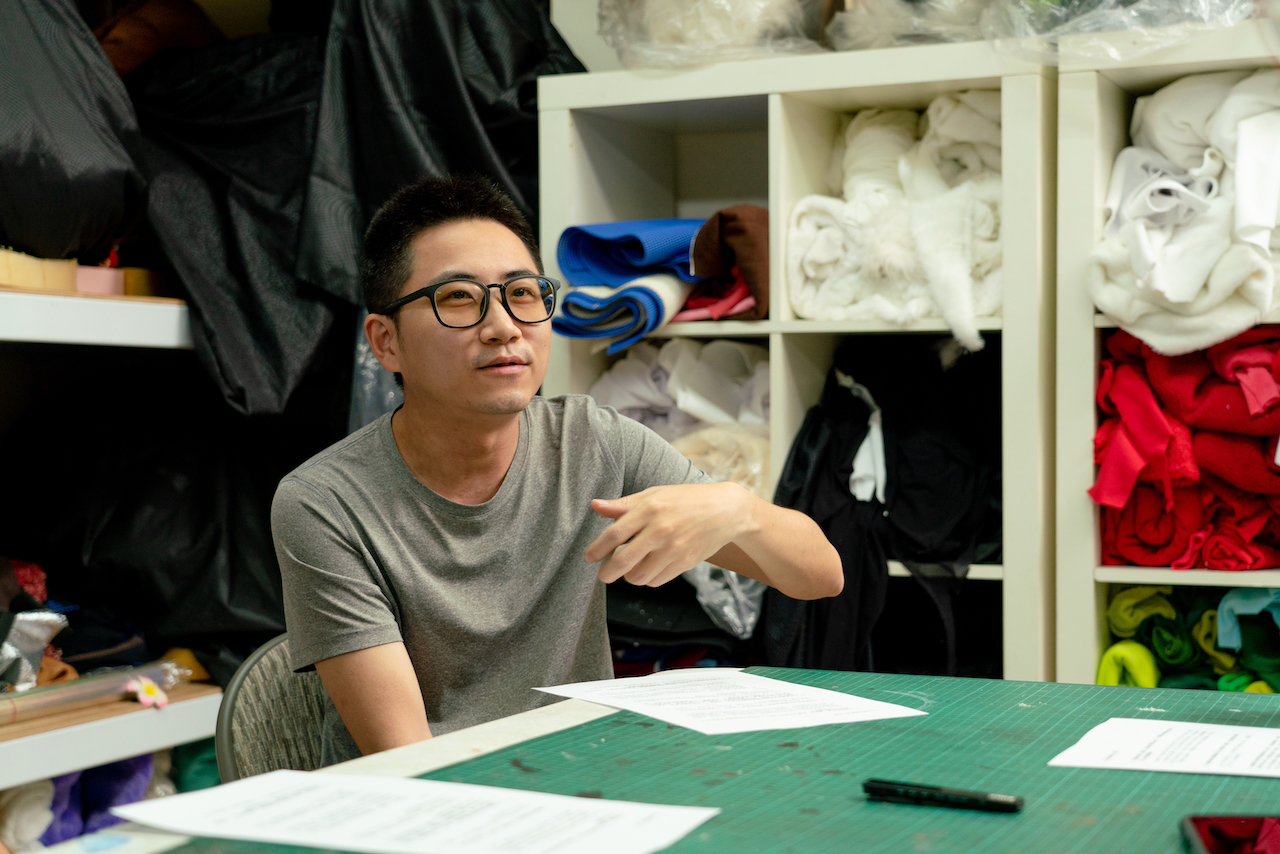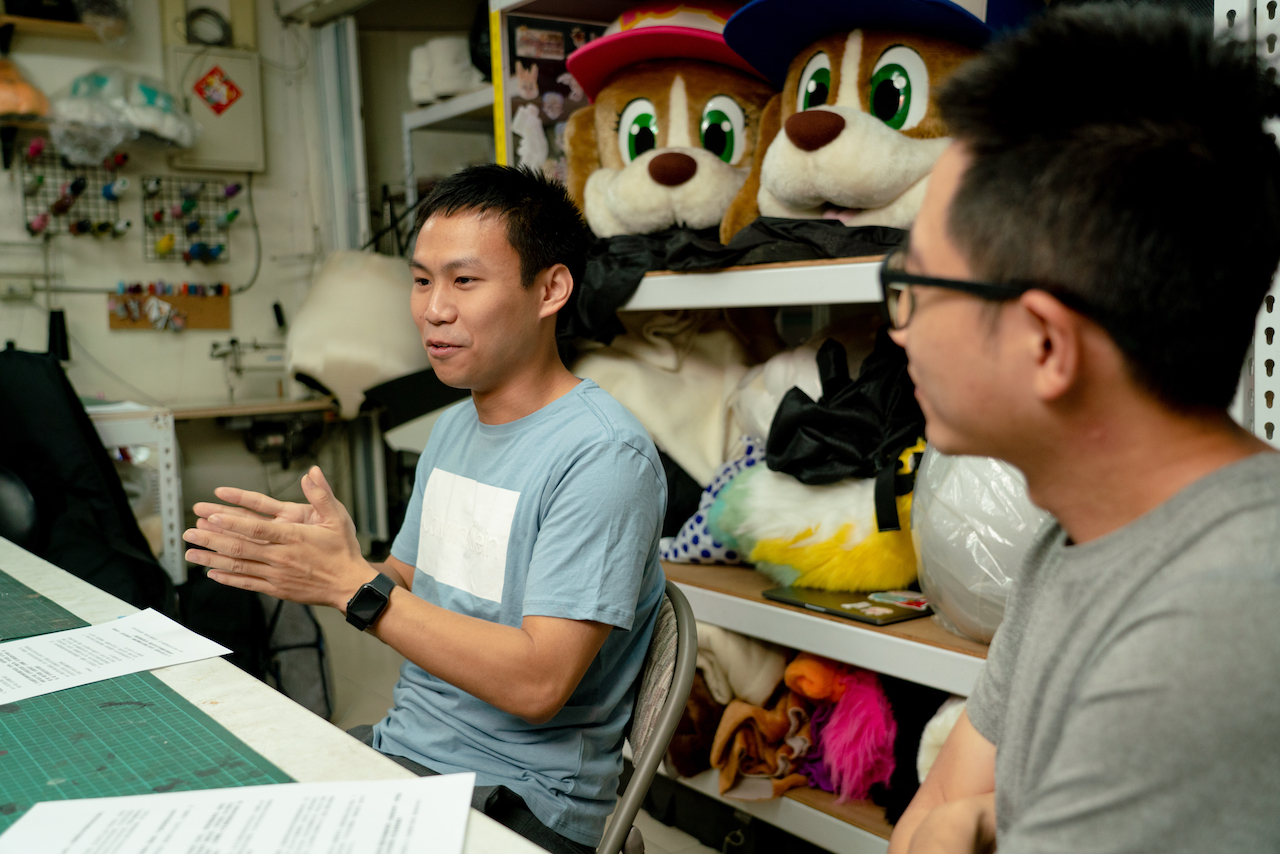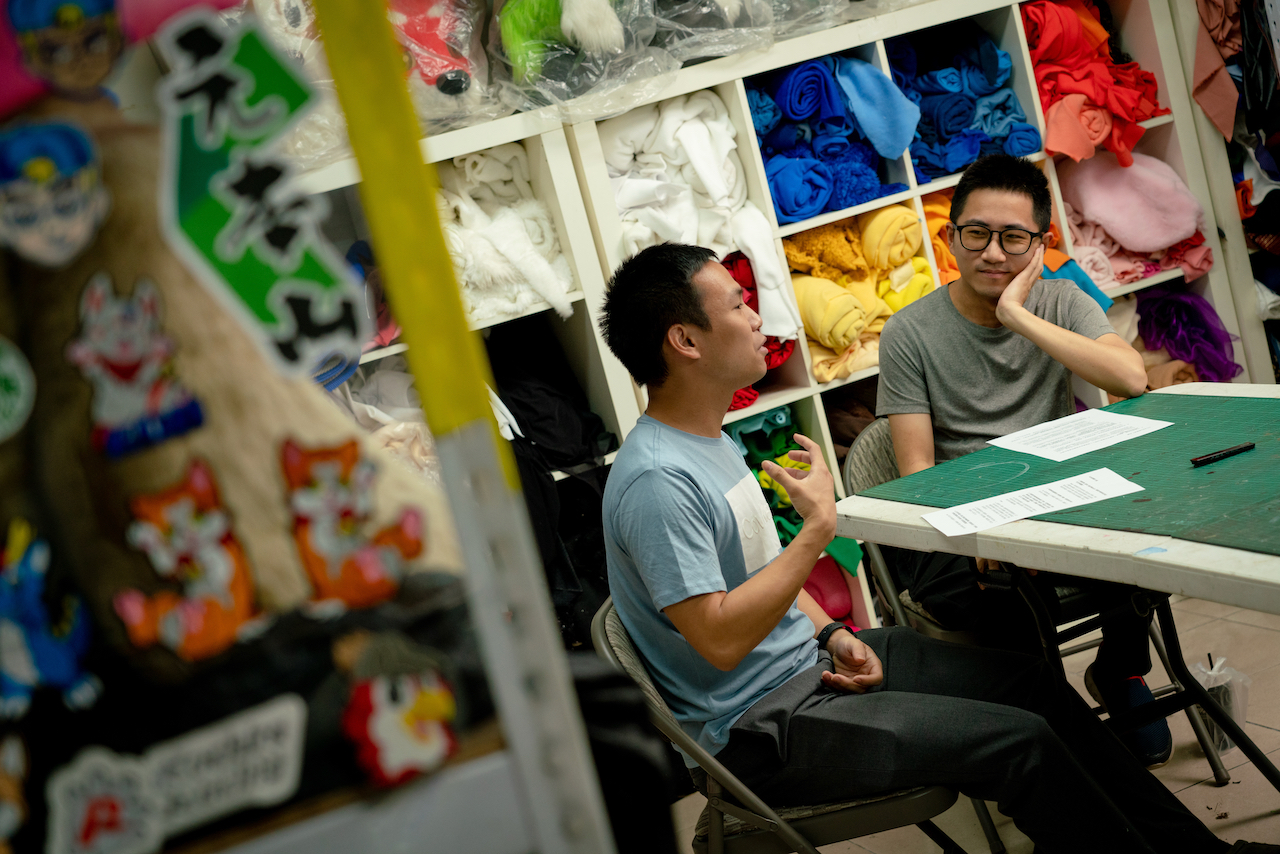千禧年之後,日本和臺灣相繼陷入「吉祥物」迷戀。2007年,日本在彥根城築城400 年紀念活動中,創生頭戴頭盔、與藩主有一段相遇故事的雪白貓咪「彥根喵」,隨之成為爆紅的城市吉祥物,日本各地進入吉祥物爆發期,陸續熊本熊、船梨精及千葉君等「國際型」角色誕生;2000年之後,臺灣商圈和政府也嘗試創造如酷客、哈比龍等角色,近年來出現的虱目魚小子、香蕉王、熊讚、高捷少女等吉祥物更具話題性,帶來觀光及活動效益。
談到吉祥物,每個臺灣人似乎都能聊上幾句。社群平台的#吉祥物標籤、與人互動的合照分享,抑或「醜到哭」的戲謔評價,從新聞報導到口耳相傳,圍繞吉祥物而生的圖像文字滲透進大眾日常。然若細究這特殊的文化生態,似乎又見樹不見林,無論是官方或新聞媒體,都難見更進一步的數量統計及分類整理。
2015年,臺北市政府為了世界大學運動會(簡稱世大運)忙碌,吉祥物原是穿插其中的輕鬆插曲。沒有料到的是,網路票選之下以「熊讚 Bravo」出道的臺灣黑熊,成為世大運及城市行銷的最大亮點,為運動會帶來高流量之餘,更是罕見在活動結束後順利轉職的吉祥物,接下臺北市的城市代言任務。
「熊讚在前臺北市長柯文哲的第一任期出現,是一個行銷策略,那時市政府的資訊局同時也創了一些角色。我們大概從那個時間點開始關心。」劉哲瑋,g0v零時政府(簡稱g0v)的長期參與者,身為路人民眾的一員,熊讚Bravo的出道歷程引起他的好奇。秉持g0v社群的理念,推動政府資訊開放和全民參與政策,他決意好好瞭解一下吉祥物,從基礎開始:「由於我不在產業中,所以就先從資料收集開始,持續蒐集到現在。」

g0v為2012年底臺灣程式設計師發起的社群,以開源(Open Source)的自由開放精神,集眾人之力開發平台及網路工具,協助公民參與政府政策的討論,每個人都能提出自己關注的議題面向,邀請他人一同協作。在劉哲瑋的召集下,「吉祥物資料集」一點一滴的形成。過去便常以資料探索為求知開端,他將政府吉祥物亮相的新聞稿、圖像等零散內容,進一步轉化成結構化資料並建立資料庫,動機很單純:「看這些資料可以告訴我們什麼?」建置過程中,他遇見熱情參與、以單人之力刊載數百筆資料的cai,也碰到Orin 2――他擔任工作筆記 3 裡有「吉祥物的內餡」之稱的操偶師職業。
「我自己本身也是從開放原始碼社群裡面出來的,但後來走了不同的路,選擇以吉祥物這一塊為主要發展,所以後來就比較少參與這些資料收集、公開等的工作。」Orin說道。成為操偶師的動機是來自某場開源社群的聚會,那次會議上他意外參與到吉祥物工作,因此愛上這塊領域。他先是加入劇團,訓練動作姿勢,最後投身熱愛的操偶工作,現開設公司接案已五年。「在傳統的印象裡,就是有人穿就好了。」Orin直白表示,許多公家體系將操偶一事看得過於簡單,然而實際上並不容易:「裡頭的視線有點像是起了大霧在看外面,看不太清楚,透過肉色的輪廓無法知道外頭的人是多高、多矮,或長什麼樣子。」若要配合活動跳舞,他形容就像是裹著棉被跳有氧,全身冒汗。

熟悉資料庫的建置及協力方式,他深諳其帶來的效益及便利:「以我們這行業來講,應該要稍微去研究一下有哪些角色,然後需要做一些業務上的連結。」Orin憶起工作現場,有時委託單位會要求多位吉祥物到場,像他自己公司就曾出動三十餘位,陣仗十分龐大。短期內能找到這麼多吉祥物出席,過去得靠記憶尋找曾合作過的吉祥物,並且要能符合業主需求、可申請授權者,官方吉祥物會是不錯的選擇:「像是有朋友舉辦與飲料相關的一個節日,就想要邀請可能喜歡喝飲料的角色,或者是跟飲料形象有契合的角色來活動,讓現場有很繽紛的畫面。」或許透過資料庫,就能聯繫到適合的角色一同出席.Orin認為,合作能讓沉寂在機關處室中的他們再度充滿活力:「因為每個角色都有他的生命跟個性,所以當角色跟角色在一起的時候,可以有很多故事。就像是不同個性的人相處,在一起自然會有很多火花。」
相較於創立新的角色,邀請不同政府單位、民間機構的吉祥物是更經濟實惠的選擇。原因無他,「吉祥物養起來很花錢的。」除了前期的開發費用外,製作布偶裝、出勤時的人力成本和運輸費都很可觀:「製作費大概就是10萬至15萬左右,若複雜點的可能要20萬。吉祥物也不能用貨運送,因為貨運常常都是直接用丟的,而且貨運公司也很難理賠損失。」Orin強調。由於大多數的貨運保險只用材料費估價,不涵括製作支付的人工費等,損壞後獲得的理賠常是不敷成本。慎重起見,吉祥物的移動往往是使用貨車接送,臺北至臺中的來回車費就將近萬元。因此讓官方吉祥物出席,既替活動方減少行銷花費,又可幫助吉祥物增加粉絲數及曝光度,達成雙贏。
 哲瑋認為:「吉祥物是面向社會的,需要更多的社會共識,因此看能不能找到一個吉祥物的治理機制。 」圖 © C-LAB,黃品維攝影
哲瑋認為:「吉祥物是面向社會的,需要更多的社會共識,因此看能不能找到一個吉祥物的治理機制。 」圖 © C-LAB,黃品維攝影
根據法規條例,政府吉祥物是採小額採購案(採購金額為10萬元以下,去年修法後增至15萬元),或者大型單位會編列常態性預算製作及維持。運用小額採購案製作的吉祥物往往面臨「斷糧」危機,沒有金援支持下便在倉庫中度過餘生。其中最容易短命的吉祥物,往往是以政治人物的形象為原型製作,一旦改朝換代、或是政黨內的派系洗牌,上位者就賜白綾三尺,打包後束之高閣。
劉哲瑋根據政府公開的標案資料彙整,發現一年在吉祥物相關的行銷預算花費大約在3,000萬至5,000萬元之間。當吉祥物沒有長期經營,意味著先前付出的成本付諸流水。免洗式吉祥物理應不是政府單位的常態,然與其扼殺低人氣的吉祥物,倒不如為每個吉祥物尋找被看見的機會:「吉祥物是面向社會的,需要更多的社會共識,因此看能不能找到一個吉祥物的治理機制。 」他試圖去尋找各部門單位的授權狀況,例如是否開放給店家製作周邊商品,或提供大眾二次創作;其次想將各單位的授權方式作成平台,提供公眾查閱之餘,也盼促成政府跨部門行銷、異業合作的機會,目前如臺北市的熊讚、臺南市的魚頭君和桃園市的ㄚ桃園哥,都已編列相關條列可申請商業版權。
官方吉祥物要長期經營並擁有持續的媒體熱度,公部門的思維翻轉是最大關鍵。劉哲瑋說:「他是一種蠻重要的公共溝通方式,不過系統的支持好像沒有那麼完整。公部門的承辦人員如果今天收到上級的指派,任務是要做一個新的角色,那他怎麼做比較好? 目前連公務人員的訓練裡面,也不一定會把這事當一個議題。」舊有的考核模式很難反應實際效益,他認為可加入關鍵字熱搜等的網路聲量檢測,藉由數據規劃不同的行銷策略。若透過教育訓練推廣至地方及中央機關,既讓更多吉祥物能得到良好照顧,又可獲得更完善的「生涯規劃」。
「人會離開,但角色不會。」與吉祥物們工作多年,操偶師Orin感觸良多,有些吉祥物誕生的目的很單純,像是在遊樂園陪著人們玩樂的角色,很希望來到此處的人開心,他是因意念而誕生的精靈,無論你/妳何時再度造訪,他依舊在此地守候。「比較理想的吉祥物,應該會是人們心靈的寄託。 傳遞一些溫度。」他工作時也常遇到工作人員會因碰到自家吉祥物開心,有時也如回到兒時,向這些角色訴苦,藉此獲得療癒和力量。Orin認為若放在社會的政策宣導上,理想的吉祥物為議題帶來溫度:「我們可能有一些公眾議題可能很冰冷, 譬如說繳稅好了,就真的很冰冷。這種很難去宣導或告訴別人的事,如果變成是吉祥物的某些行為,轉化成他的一個故事或一個生活過程的話,就會變得很有趣,不只是一個議題而已。」
劉哲瑋則對具在地特色的吉祥物傾心,「石碇用一隻鱷魚當吉祥物,選擇鱷魚是跟當地的特色風景有關。」因為當地鄰近翡翠水庫,若在石碇高處向下俯視,水庫中的大島嶼就像一隻淡定自若的鱷魚蹲踞,有鱷魚島之稱,所以當地商圈借用此形象,創造出吉祥物「淡碇鱷」。這類具有在地特色的吉祥物不僅喚起民眾的生命經驗,亦是鄉鎮凝聚力的展現。苗栗縣因有保育類動物石虎出沒,於是用石虎的形象設計「貓裏喵」,古靈精怪的表情和圓潤身軀深受大眾喜愛,因此2019年在網路票選之下,成為政府新啟用的親子公園名稱。當吉祥物形象能夠在一個縣市政府下的每個單位靈活運用,甚而成為公共設施的名字,劉哲瑋相信這不光加深大眾對吉祥物的印象、提升了網路聲量,也是更有效益的運用。
 無論是劉哲瑋等人透過資料庫建置,或是Orin直接以吉祥物作為工作職志,他們以不同的方式檢視、探討公共資源是如何被使用在吉祥物方面的實踐。圖 © C-LAB,黃品維攝影
無論是劉哲瑋等人透過資料庫建置,或是Orin直接以吉祥物作為工作職志,他們以不同的方式檢視、探討公共資源是如何被使用在吉祥物方面的實踐。圖 © C-LAB,黃品維攝影
而爬梳資料集中的內容,他也發現有趣的現象,那就是即便臺灣物種多達15萬種,近三成更是臺灣特有種或亞種,不過吉祥物用臺灣保育類動物設計「撞臉」的機率卻不低,像臺灣黑熊便是吉祥物的熱門選擇。如今同樣是胸口有V型記號的熊吉祥物,交通部觀光局的叫「台灣喔熊」;高雄觀光局是穿著花褲的「高雄熊」;在臺北市政府有辦公室的是「熊讚」;臺鐵出沒的叫作「餐旅熊」。以臺灣黑熊為原型的吉祥物眾多,不過挪用圖像的同時,卻未觸及真實的困境,劉哲瑋指出:「基本上使用動物創作角色沒有版權問題,當然可以用臺灣黑熊,只是你運用圖像的時候,卻與真實的臺灣黑熊保育行動沒有任何關聯。」該如何將生態議題納入其中,最直接的方式是讓吉祥物出席參與保育協會的活動,運用曝光度而宣傳政策。「目前臺灣黑熊保育協會也倡議,將吉祥物的盈利收入部分捐出,作為保育活動資金。」劉哲瑋相信,這類的公眾回饋實質支持了保育活動,吉祥物亦成為媒介,拉近公眾與臺灣這塊土地的距離。
吉祥物資料庫建置至今為止,已蒐集1,300餘個吉祥物,其中公家機關創建的角色有938個,分別隸屬372 個公眾屬性單位(包含:中央部會與所屬單位、國營事業、縣市政府與所屬單位、鄉鎮區公所、農會、大學與大專院校、國立高級中級學校、國中小學)。身為這項專案的創始人,劉哲瑋仍在思考著下一步該怎麼走:如何為吉祥物找到贊助的法規?是否能有不一樣的專家學者意見?該如何著手分類吉祥物的應用目的,讓防災推廣、節能減碳的宣導功能被看見?他和文化部的文創發展司聯繫,瞭解IP( intellectual property)產業發展的可能性。蒐集資料庫,真的只是他的一小步:「加入open source的頻道,先進來看看我們的討論,然後想做什麼就自己挖掘吧!」